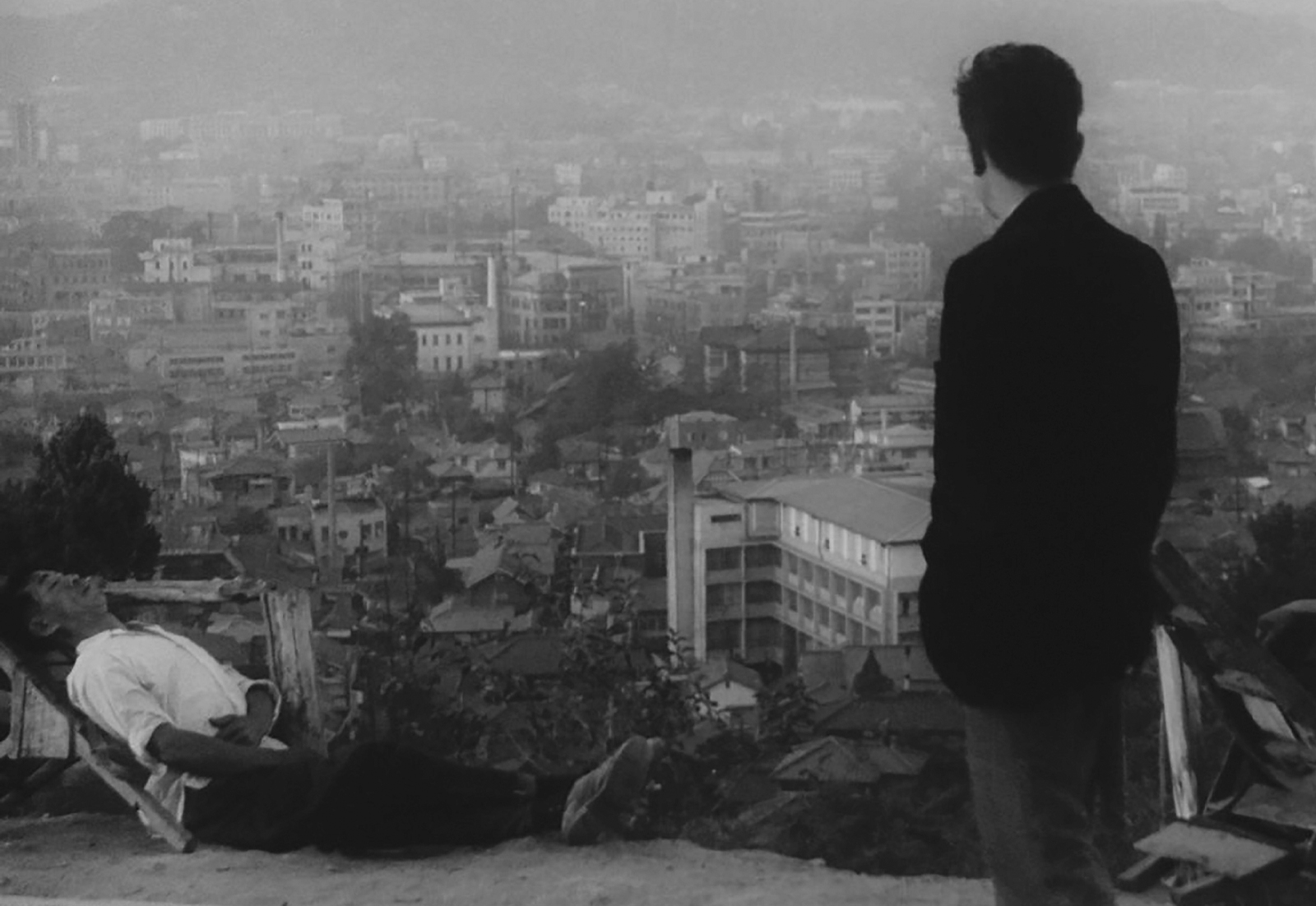AIMLESS BULLET (OBALTAN)


11:00AM, Sunday October 17
Classic Cinemas, Elsternwick
Introduced by Russell Edwards
Original Name: Obaltan (Stray Bullet)
Director: Yu Hyun-mok
Country: Korea
Year: 1961
Runtime: 107 minutes
Language: Korean, with English subtitles
Format: Black and White, 2K DCP (originally 35mm)
Rating: Unclassified 15+
Classic Cinemas, Elsternwick
Introduced by Russell Edwards
Original Name: Obaltan (Stray Bullet)
Director: Yu Hyun-mok
Country: Korea
Year: 1961
Runtime: 107 minutes
Language: Korean, with English subtitles
Format: Black and White, 2K DCP (originally 35mm)
Rating: Unclassified 15+
Tickets ⟶
Aimless Bullet is Yu Hyun-mok’s most exemplary work and a key piece of Korean realist cinema. — Korean Cultural Centre
Aimless Bullet masterfully captures the collective anxiety of post-war Korea through the characters of clerk Cheol-ho and his family — his mother who lives with a mental illness, his bank-robber brother and his sex-worker sister. Through this family microcosm, the film explores the enduring sense of hopelessness that permeated Korean society after the Japanese occupation instituted a culture of domination and exploitation. Banned shortly after its first screenings by the then military government, Aimless Bullet has now been painstakingly restored by the Korean Film Archive. Cinema Reborn’s screening will be the first for the restoration in Australia.
Presented in a 2K Restoration by The Korean Film Archive
Aimless Bullet masterfully captures the collective anxiety of post-war Korea through the characters of clerk Cheol-ho and his family — his mother who lives with a mental illness, his bank-robber brother and his sex-worker sister. Through this family microcosm, the film explores the enduring sense of hopelessness that permeated Korean society after the Japanese occupation instituted a culture of domination and exploitation. Banned shortly after its first screenings by the then military government, Aimless Bullet has now been painstakingly restored by the Korean Film Archive. Cinema Reborn’s screening will be the first for the restoration in Australia.
Presented in a 2K Restoration by The Korean Film Archive
Film Notes by Russell Edwards:
Yu Hyun-mok
Beginning his film career as an
assistant director in 1946, Yu Hyun-mok was in the vanguard of Korean cinema as
the peninsula emerged from Japanese Occupation and was ready to forge its place
as a creative nation. Directing his first film The Crossroad (Gyocharo)
in 1956, Yu completed 42 commercially released features of which the most
renowned and most widely seen is Aimless
Bullet (Obaltan, 1961). Commonly,
if misleadingly described as a realist, some of Yu’s films, such as An Empty Dream (Chunmong, 1965) have a strong experimental streak which demonstrate
his passion for breaking barriers: social, political and artistic. He didn’t
always come through unscathed. Yu was arrested on obscenity charges over An Empty Dream and much of his work in
the 1970s and 1980s was compromised by government interference — though Rainy Days (Jangma, 1979) demonstrates his ability to create strong cinema even
under such constraints. From the mid-70s, Yu taught at Seoul’s Dongguk
University where he also continued his forays into experimental film. In the
early days of the Busan International Film Festival, Yu, a dedicated
chain-smoker, could be easily spotted because he was always accompanied by a
large halo of swirling tobacco smoke. Yu died, aged 83, in 2009.
The Film
Aimless Bullet, Yu Hyun-mok’s most
acclaimed film, was born as the window of democracy was opening in
impoverished, post-civil war South Korea, and before Park Chung-hee’s
dictatorship slammed the window shut in 1961. The film portrays South Korea in
the microcosmic form of an impoverished family. Like Yu who was born in the northern
province of Hwanghae, the family are cut off from their ancestral home by the
division of the peninsula which was a by-product of the Korean War (1950-53).
Chol-ho is an honest and poorly paid public accountant who not only struggles
to support his pregnant wife and daughter, but lives with his extended clan.
Chol-ho’s brother Yong-ho is an angry and rebellious army veteran who feels abandoned
by the freedom for which he fought. To make ends meet their sister, Myong-suk
fraternises with the new occupiers — the American soldiers — much to the shame
of both her brothers. In a society that treasures the worth of education, the
very youngest brother, drops out of high school to sell newspapers on the
street. Their bed-ridden mother is unhinged by the trauma and her frequent
refrain of “Let’s get out of here” serves only to remind the other family
members that there is nowhere to go.
Yu was a dedicated Christian. His later films, Martyr (Sungyoja 1965) and Son of Man (Salamui Adeul, 1980) directly explore issues of faith, but Aimless Bullet offers mere flashes of Christian imagery such as marching citizens carrying placards about Jesus during the film’s noir-ish bank robbery. However, Yu doesn’t minimise the post-war trauma of living in an impoverished environment with pat spiritual philosophy. After playing with neo-realism, expressionism, melodrama, theatricality, and noir, the film’s final images border on the abstract. Yu’s narrative leaves the audience to reflect on its own choices on what to believe in, and what to do next.
The shoot went on for over a year. According to a 1999 interview with the director, Yu and most of the crew worked for minimum wage and sometimes for free. “As we got money, we would get some rolls of film and shoot for a couple of days and stop for a while until the money came in.” The financial difficulties and the resultant extended breaks between bursts of shooting account for stylistic differences within the film. There was also the added interruption of a popular student uprising which was partially welcome as Yu explained: [the] “Resulting freedom of expression was applied in a broader sense making possible for the film to be more charged with social issues. At any rate it was a hard labour giving birth to that film.” Unfortunately, those freedoms proved short-lived as censorship laws introduced by the new government created an atmosphere more repressive than when Yu started shooting. As a result, Aimless Bullet had a limited release in Seoul only, but amongst those who flocked to the limited screenings, the response to Aimless Bullet was passionate.
Yu was a dedicated Christian. His later films, Martyr (Sungyoja 1965) and Son of Man (Salamui Adeul, 1980) directly explore issues of faith, but Aimless Bullet offers mere flashes of Christian imagery such as marching citizens carrying placards about Jesus during the film’s noir-ish bank robbery. However, Yu doesn’t minimise the post-war trauma of living in an impoverished environment with pat spiritual philosophy. After playing with neo-realism, expressionism, melodrama, theatricality, and noir, the film’s final images border on the abstract. Yu’s narrative leaves the audience to reflect on its own choices on what to believe in, and what to do next.
The shoot went on for over a year. According to a 1999 interview with the director, Yu and most of the crew worked for minimum wage and sometimes for free. “As we got money, we would get some rolls of film and shoot for a couple of days and stop for a while until the money came in.” The financial difficulties and the resultant extended breaks between bursts of shooting account for stylistic differences within the film. There was also the added interruption of a popular student uprising which was partially welcome as Yu explained: [the] “Resulting freedom of expression was applied in a broader sense making possible for the film to be more charged with social issues. At any rate it was a hard labour giving birth to that film.” Unfortunately, those freedoms proved short-lived as censorship laws introduced by the new government created an atmosphere more repressive than when Yu started shooting. As a result, Aimless Bullet had a limited release in Seoul only, but amongst those who flocked to the limited screenings, the response to Aimless Bullet was passionate.
The Restoration
Despite being the first Korean film to be accepted by New
York’s Museum of Modern Art, and remaining the most famous film of the pre-Hallyu era, for many years the only
source print of Aimless Bullet was
enough to make film buffs shake their heads in despair. Due to 678
hand-lettered English subtitles that had been burned into the surviving print,
restoration for Aimless Bullet was a
more arduous task than the usual time-consuming removal of dust, stains and
scratches from the image. The Korean Film Archive spent two years removing the
subtitles with the use of visual effects before the print was returned to
anything like its original state.
